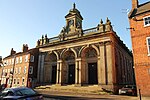River Devon, Nottinghamshire

The River Devon is a tributary of the River Trent, which rises in Leicestershire and joins the Trent at Newark in Nottinghamshire, England. In its upper reaches, it supplies Knipton Reservoir, which was built to supply water to the Grantham Canal, and Belvoir Lakes, designed by Capability Brown. It passes under the Grantham Canal, and then through Bottesford, where it is spanned by five railway bridges, only one of which is still used for its original purpose. On the outskirts of Newark, it passes by two Civil War structures, and just before it joins the Trent it becomes navigable, with a marina located on the west bank. Its name is pronounced "Deevon", not as spelt.
Excerpt from the Wikipedia article River Devon, Nottinghamshire (License: CC BY-SA 3.0, Authors, Images).River Devon, Nottinghamshire
Mill Gate, Newark and Sherwood Newark
Geographical coordinates (GPS) Address Nearby Places Show on map
Geographical coordinates (GPS)
| Latitude | Longitude |
|---|---|
| N 53.0717 ° | E -0.8231 ° |
Address
Newark Marina
Mill Gate
NG24 4TY Newark and Sherwood, Newark
England, United Kingdom
Open on Google Maps








